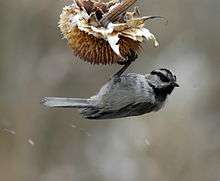Mountain chickadee
The mountain chickadee (Poecile gambeli) is a small songbird, a passerine bird in the tit family Paridae.
| Mountain chickadee | |
|---|---|
.jpg) | |
| Scientific classification | |
| Kingdom: | Animalia |
| Phylum: | Chordata |
| Class: | Aves |
| Order: | Passeriformes |
| Family: | Paridae |
| Genus: | Poecile |
| Species: | P. gambeli |
| Binomial name | |
| Poecile gambeli Ridgway, 1886 | |
 | |
| Range of Poecile gambeli | |
| Synonyms | |
|
Parus gambeli | |
Adults of both sexes have a black cap joining a black postocular stripe behind distinctive white eyebrows. Their backs and flanks are gray and they have paler gray underparts; they have a short black bill, and a black bib. The typical adult wingspan is 7.5 in (19 cm), and the overall length is 5–6 in (13–15 cm).
Common inhabitants of the mountainous regions of the western United States, their range extends from the southern Yukon to California and Rocky Mountain States in the United States. A few mountain chickadees may migrate locally up the mountains in the summer and down into the mountain foothills in the winter; but this phenomenon is not well documented.
They breed monogamously, producing 1 to 2 broods per year. Incubation by the female is 14 days. The young are altricial, and stay in the nest for 21 days while being fed by both parents.
Their primary diet is insects during the summer and breeding season; conifer seeds and other plant seeds are taken throughout the year. They cling to the undersides of branches and to tree trunks, searching for food in the bark or breaking seeds open by hammering them with their beaks.
Their call is a throaty chick-adee-dee-dee, while their song is a 3- or 4-note descending whistle fee-bee-bay or fee-bee-fee-bee. Their song sounds like it is whistling the word "Cheeseburger". They travel in pairs or small groups, and may join multi-species feeding flocks after breeding season.
Recent studies have indicated that in mixed flocks, black-capped chickadees become dominant over mountain chickadees.
The specific name honors naturalist William Gambel.
The mountain chickadee was formerly placed in the genus Parus with most other tits, but mtDNA cytochrome b sequence data and morphology suggest that separating Poecile more adequately expresses these birds' relationships.[2] Molecular phylogenetic studies have shown that the mountain chickadee is sister to the black-capped chickadee (Poecile atricapillus).[3][4]
Gallery
References
- BirdLife International (2012). "Parus gambeli". IUCN Red List of Threatened Species. 2012. Retrieved 26 November 2013.CS1 maint: ref=harv (link)
- Gill, Frank B.; Slikas, Beth; Sheldon, Frederick H. (2005). "Phylogeny of titmice (Paridae): II. Species relationships based on sequences of the mitochondrial cytochrome-b gene". Auk. 122: 121–143. doi:10.1642/0004-8038(2005)122[0121:POTPIS]2.0.CO;2.
- Johansson, Ulf S.; Ekman, Jan; Bowie, Rauri C. K.; Halvarsson, Peter; Ohlson, Jan I.; Price, Trevor D.; Ericson, Per G. P. (2013). "A complete multilocus species phylogeny of the tits and chickadees (Aves: Paridae)". Molecular Phylogenetics and Evolution. 69 (3): 852–860. doi:10.1016/j.ympev.2013.06.019.
- Tritsch, Christian; Martens, Jochen; Sun, Yue-Hua; Heim, Wieland; Strutzenberger, Patrick; Päckert, Martin (2017). "Improved sampling at the subspecies level solves a taxonomic dilemma – A case study of two enigmatic Chinese tit species (Aves, Passeriformes, Paridae, Poecile)". Molecular Phylogenetics and Evolution. 107: 538–550. doi:10.1016/j.ympev.2016.12.014.
- Alsop, Fred J., III (2001). Smithsonian Birds of North America, Western Region. New York City: DK Publishing, Inc. ISBN 0-7894-7157-4.
External links
| Wikimedia Commons has media related to Poecile gambeli. |
| Wikispecies has information related to Poecile gambeli |
- Mountain chickadee - Poecile gambeli - USGS Patuxent Bird Identification InfoCenter
- Mountain chickadee Species Account - Cornell Lab of Ornithology
- Mountain chickadee photo gallery at VIREO (Drexel University)
- "Mountain chickadee media". Internet Bird Collection.
- BirdLife species factsheet for Poecile gambeli
- "Poecile gambeli". Avibase.

- Interactive range map of Poecile gambeli at IUCN Red List maps
- Audio recordings of Mountain chickadee on Xeno-canto.





